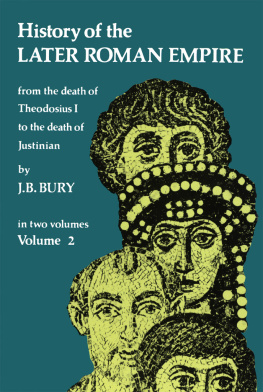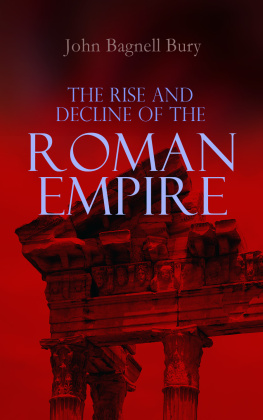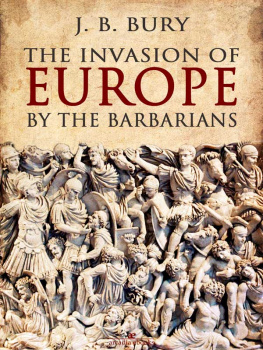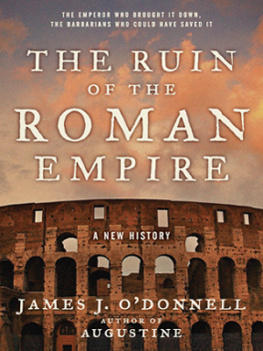J. B. Bury - History of the Later Roman Empire, Vol. 2
Here you can read online J. B. Bury - History of the Later Roman Empire, Vol. 2 full text of the book (entire story) in english for free. Download pdf and epub, get meaning, cover and reviews about this ebook. year: 2013, publisher: Dover Publications, genre: Non-fiction. Description of the work, (preface) as well as reviews are available. Best literature library LitArk.com created for fans of good reading and offers a wide selection of genres:
Romance novel
Science fiction
Adventure
Detective
Science
History
Home and family
Prose
Art
Politics
Computer
Non-fiction
Religion
Business
Children
Humor
Choose a favorite category and find really read worthwhile books. Enjoy immersion in the world of imagination, feel the emotions of the characters or learn something new for yourself, make an fascinating discovery.
- Book:History of the Later Roman Empire, Vol. 2
- Author:
- Publisher:Dover Publications
- Genre:
- Year:2013
- Rating:5 / 5
- Favourites:Add to favourites
- Your mark:
- 100
- 1
- 2
- 3
- 4
- 5
History of the Later Roman Empire, Vol. 2: summary, description and annotation
We offer to read an annotation, description, summary or preface (depends on what the author of the book "History of the Later Roman Empire, Vol. 2" wrote himself). If you haven't found the necessary information about the book — write in the comments, we will try to find it.
J. B. Bury: author's other books
Who wrote History of the Later Roman Empire, Vol. 2? Find out the surname, the name of the author of the book and a list of all author's works by series.
History of the Later Roman Empire, Vol. 2 — read online for free the complete book (whole text) full work
Below is the text of the book, divided by pages. System saving the place of the last page read, allows you to conveniently read the book "History of the Later Roman Empire, Vol. 2" online for free, without having to search again every time where you left off. Put a bookmark, and you can go to the page where you finished reading at any time.
Font size:
Interval:
Bookmark:
history of the
LATER ROMAN EMPIRE
FROM THE DEATH OF
THEODOSIUS I.
TO THE DEATH OF
JUSTINIAN
by J. B. Bury
In two volumes
Volume Two
DOVER PUBLICATIONS, INC., NEW YORK
This Dover edition, first published in 1958, is an unabridged and unaltered republication of the first edition. It is published by special arrangement with St. Martins Press.
International Standard Book Number eISBN 13: 978-0-486-14339-2
Library of Congress Catalog Card Number: 58-11273
Manufactured in the United States by Courier Corporation
20399915
www.doverpublications.com
CONTENTS
VOL. II
MAPS
GENEALOGICAL TABLE OF THE HOUSE OF JUSTIN
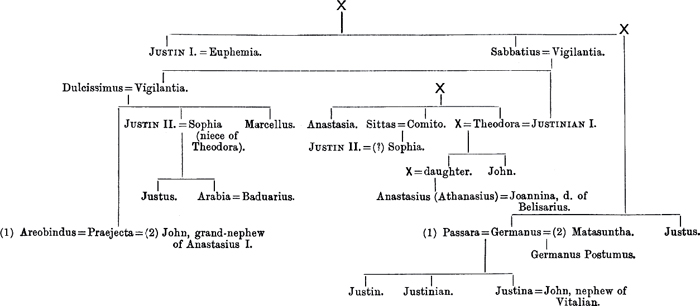
CHAPTER XIV
THE EMPIRE AND PERSIA
1. Relations with Persia in the Fifth Century
T HE rulers of Constantinople would hardly have steered their section of the Empire with even such success as they achieved through the dangers which beset it in the fifth century, had it not been that from the reign of Arcadius to that of Anastasius their peaceful relations with the Sassanid kings of Persia were only twice interrupted by brief hostilities. The unusually long duration of this period of peace, notwithstanding the fact that the conditions in Armenia constantly supplied provocations or pretexts for war, was in a great measure due to the occupation of Persia with savage and dangerous enemies who threatened her north-eastern frontier, the Ephthalites or White Huns, but there was a contributory cause in the fact that the power of the Sassanid kings at this time was steadily declining. It is significant that when, at the end of the fifth century, a monarch arose who was able to hold his own against the encroachments of the Zoroastrian priesthood and the nobility, grave hostilities immediately ensued which were to last with few and uneasy intervals for a hundred and thirty years.
At the accession of Arcadius, Varahran IV. was on the Persian throne, but was succeeded in A.D. 399 by Yezdegerd I. The policy of this sovran was favourable to his Christian subjects, who had been allowed to recover from the violent persecution which they had suffered at the hands of Sapor, the conqueror of Julian; and he was an object of veneration to Christian historians, Yezdegerd took the wish of his brother as a compliment and declared that the enemies of Theodosius would have to deal with him.
Whatever be the truth about this record, which is not mentioned by contemporary writers,
It is possible that at the same time the commercial relations between the two realms were under discussion. It was the policy of both powers alike to restrict the interchange of merchandise to a few places close to the frontier. Persian merchants never came to Constantinople, Roman merchants never went to Ctesiphon. The governments feared espionage under the guise of trade, and everything was done to discourage free intercourse between the two states. Before the treaty of Jovian, Nisibis was the only Roman town in which Persian merchants were allowed to trade.
The attention of Varahran was soon occupied by the appearance of new enemies beyond the Oxus, who for more than a hundred years were constantly to distract Persian arms from the Roman frontier.
The reign of Theodosius II. witnessed a second but less serious disturbance of the peace, soon after the accession of Yezdegerd II. ( A.D. 438). The cause is uncertain. It has been conjectured, without sufficient evidence, that the Persian king was in league
The greater part of Yezdegerds reign was troubled by war with the Ephthalites. He made energetic efforts to convert Persian Armenia to the religion of Zoroaster, but the Armenians were tenacious of their Christianity and offered steady resistance to his armies. Since A.D. 428, when the last Arsacid king, Ardashir, had been deposed by the Persian monarch at the The war between the Armenians and their overlord continued after the death of Yezdegerd ( A.D. 453) during the reign of Firuz (Perozes), under the leadership of Vahan the Mamigonian.
Firuz perished in a war with the Ephthalites, whose king had devised a cunning stratagem of covered ditches which were fatal to the Persian cavalry ( A.D. 484). Valakhesh (Balas), perhaps his brother, followed him, and enjoyed a shorter but more peaceable reign. He made a treaty with the enemy, consenting to pay them a tribute for two years. He pacified Armenia by granting unreserved toleration; Vahan was appointed its governor; and Christianity was reinstated. Valakhesh died in A.D. 488.
During this periodthe reigns of Marcian, Leo, and Zenothere had been no hostilities between the two empires, but there had been diplomatic incidents. About A.D. 464 Perozes had demanded money from Leo for the defence of the Caucasian passes, had complained of the reception of Persian refugees, and of the persecution of the Zoroastrian communities which still existed on Roman territory.
It was one of these ministers to whom Kavad owed his elevation.
Kavad might not have found it easy to emancipate the throne from the tutelage to which it had so long submitted, if there had not been a remarkable popular movement at the time of which he boldly took advantage. Mazdak was imprisoned, but forcibly released by his disciples. After a confinement of two or three years Kavad found means to escape, and with the help of the Ephthalites was reinstated on the throne ( A.D. 499).
Towards the end of his reign his position was so strong that he was able to take measures to suppress the anti-social Mazdakite sect, which he had suffered only because the hostility between these enthusiasts and the nobles and priests helped him to secure and consolidate the royal power.
2. The Persian War of Anastasius ( A.D. 502507)
It was some time after the restoration of Kavad that hostilities broke out, after sixty years of peace between Persia and the Empire. In their financial embarrassments the Sassanid kings were accustomed to apply to Constantinople, and to receive payments which were nominally the bargained contribution to the defence of the Caucasian passes. The Emperors Leo and Zeno had extricated Perozes from difficulties by such payments.
The Persian monarch began operations with an invasion of Armenia, and Theodosiopolis fell into his hands by treachery. Then he marched southwards, attacked Martyropolis which surrendered, and laid siege to Amida. This city, after a long and laborious winter siege beginning in October, was surprised in January ( A.D. 503), chiefly through the negligence of some monks who had undertaken to guard one of the towers, and having drunk too much wine slumbered instead of watching.
On the first news of the invasion the Emperor had sent Rufinus as an ambassador to offer money and propose terms of peace.
The campaign opened (May, A.D. 503) with a success for Areobindus, in the neighbourhood of Nisibis, but the enemy soon mustered superior forces and compelled him to withdraw to Constantia. The jealousy of Hypatius and Patricius, who with 40,000 men had encamped
Areobindus meanwhile had shut himself up in Edessa, and Kavad determined to attack it. The Christian legend of Edessa was in itself a certain challenge to the Persian kings. It was related that Abgar, prince of Edessa and friend of the Emperor Augustus, suffered in his old age from severe attacks of gout. Hearing of the miraculous cures which Jesus Christ was performing in Palestine, Abgar wrote to him, inviting him to leave a land of unbelievers and spend the rest of his life at Edessa. Jesus declined, but promised the prince recovery from his disease. But notwithstanding this sign Kavad persisted in his evil intention.
Next pageFont size:
Interval:
Bookmark:
Similar books «History of the Later Roman Empire, Vol. 2»
Look at similar books to History of the Later Roman Empire, Vol. 2. We have selected literature similar in name and meaning in the hope of providing readers with more options to find new, interesting, not yet read works.
Discussion, reviews of the book History of the Later Roman Empire, Vol. 2 and just readers' own opinions. Leave your comments, write what you think about the work, its meaning or the main characters. Specify what exactly you liked and what you didn't like, and why you think so.

